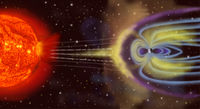Tầng điện ly

Tầng điện ly[1] (tiếng Anh: ionosphere) là phần bị ion hóa của thượng tầng khí quyển Trái Đất, từ khoảng 48 km (30 mi) đến 965 km (600 mi) trên mực nước biển.[2] Đây là một khu vực bao gồm tầng nhiệt và các phần của tầng trung lưu và tầng ngoài. Tầng điện ly bị ion hóa bởi bức xạ Mặt Trời. Nó đóng một vai trò quan trọng trong điện khí quyển và tạo ra cạnh bên trong (inner edge) của từ quyển. Tầng điện ly có tầm quan trọng trong thực tế, bởi vì nó ảnh hưởng đến sự truyền sóng vô tuyến đến những nơi xa xôi trên Trái Đất.[3] Nó cũng ảnh hưởng đến tín hiệu GPS truyền qua tầng này.
Lịch sử nghiên cứu
[sửa | sửa mã nguồn]
Năm 1878, nhà toán học và vật lý người Đức Carl Friedrich Gauß đã đưa ra giả thuyết rằng một vùng dẫn điện của bầu khí quyển có thể giải thích cho các biến thiên quan sát được của từ trường Trái Đất.[4] 60 năm sau, Guglielmo Marconi nhận được tín hiệu vô tuyến xuyên Đại Tây Dương đầu tiên vào ngày 12 tháng 12 năm 1901 tại St. John's, Newfoundland (nay thuộc Canada) bằng cách sử dụng ăngten dài 152,4 m (500 ft) để thu sóng. Trạm phát ở Poldhu, Cornwall đã sử dụng máy phát sóng khoảng cách tia lửa để tạo ra tín hiệu có tần số xấp xỉ 500 kHz và công suất gấp 100 lần so với bất kỳ tín hiệu vô tuyến nào được tạo ra trước đây. Tin nhắn nhận được là ba dits, mã Morse cho chữ S. Để đến được Newfoundland, tín hiệu sẽ phải bật ra khỏi tầng điện ly hai lần. Tuy nhiên, tiến sĩ Jack Belrose đã phản đối điều này dựa trên công trình lý thuyết và thực nghiệm.[5] Tuy nhiên, Marconi đã nhận được thông tin liên lạc không dây xuyên Đại Tây Dương ở Vịnh Glace, Nova Scotia một năm sau đó.[6]
Năm 1902, Oliver Heaviside đề xuất sự tồn tại của lớp Kennelly–Heaviside của tầng điện ly.[7] Cũng trong năm 1902, Arthur Edwin Kennelly đã phát hiện ra một số tính chất điện vô tuyến của tầng điện ly.[8]
Tham khảo
[sửa | sửa mã nguồn]- ^ T.X.Q (ngày 11 tháng 5 năm 2008). "Nghiên cứu tầng điện ly theo phong cách 4D". Báo Thanh Niên. Truy cập ngày 17 tháng 7 năm 2023.
- ^ Zell, Holly (ngày 2 tháng 3 năm 2015). "Earth's Atmospheric Layers". NASA. Truy cập ngày 23 tháng 10 năm 2020.
- ^ Rawer, K. (1993). Wave Propagation in the Ionosphere. Dordrecht: Kluwer Academic. ISBN 0-7923-0775-5.
- ^ Gauss, Carl Friedrich (1839). "Allgemeine Theorie des Erdmagnetismus [General theory of terrestrial magnetism]". Trong Gauss, Carl Friedrich; Weber, Wilhelm (biên tập). Resultate aus den Beobachtungen des Magnetischen Vereins im Jahre 1838 [Findings from the Observations of the Magnetic Society in the Year 1838] (bằng tiếng German). Leipzig, (Germany): Weidmanns' Bookshop. tr. 1–57.
{{Chú thích sách}}: Quản lý CS1: ngôn ngữ không rõ (liên kết) Gauss speculated that magnetic forces might be generated not only by electrical currents flowing through the Earth's interior but also by some sort of electrical current(s) flowing through the atmosphere. From p. 50: "§ 36. Ein anderer Theil unserer Theorie, über welchen ein Zweifel Statt finden kann, ist die Voraussetzung, ... zu untersuchen , wie die aus denselben hervorgehende magnetische Wirkung auf der Erdoberfläche sich gestalten würde." (Another part of our theory about which doubt may arise is the assumption that the agents of terrestrial magnetic force have their source exclusively in the interior of the Earth. If the immediate causes [of terrestrial magnetism] should be sought entirely or in part outside [the Earth's interior], then we can — in so far as we exclude baseless fantasies and we want to restrict ourselves to the scientifically known [facts] — consider only galvanic currents. Atmospheric air is not a conductor of such currents; empty space also is not: thus our knowledge fails us when we seek a carrier for galvanic currents in the upper regions [of the atmosphere]. Only the enigmatic phenomena of the northern lights — in which by all appearances electricity in motion plays a major role — prohibits us from simply denying the possibility of such currents just on account of that ignorance, and in any case it remains interesting to investigate how the magnetic effect resulting from [those currents] would manifest itself on the Earth's surface.)- English translation: Gauss, Carl Friedrich; Sabine, Elizabeth Juliana, trans. (1841). "General theory of terrestrial magnetism". Trong Taylor, Richard (biên tập). Scientific Memoirs, Selected from the Transactions of Foreign Academies of Science and Learned Societies, and from Foreign Journals. London, England: Richard and John E. Taylor. tr. 184–251.
{{Chú thích sách}}: Quản lý CS1: nhiều tên: danh sách tác giả (liên kết) See p. 229. - English translation: Glassmeier, K.-H; Tsurutani, B. T. (2014). "Carl Friedrich Gauss – General Theory of Terrestrial Magnetism – a revised translation of the German text". History of Geo- and Space Sciences. Quyển 5 số 1. tr. 11–62. Bibcode:2014HGSS....5...11G. doi:10.5194/hgss-5-11-2014.
- English translation: Gauss, Carl Friedrich; Sabine, Elizabeth Juliana, trans. (1841). "General theory of terrestrial magnetism". Trong Taylor, Richard (biên tập). Scientific Memoirs, Selected from the Transactions of Foreign Academies of Science and Learned Societies, and from Foreign Journals. London, England: Richard and John E. Taylor. tr. 184–251.
- ^ John S. Belrose, "Fessenden and Marconi: Their Differing Technologies and Transatlantic Experiments During the First Decade of this Century Lưu trữ ngày 23 tháng 1 năm 2009 tại Wayback Machine". International Conference on 100 Years of Radio, 5–7 September 1995.
- ^ "Marconi and the History of Radio". IEEE Antennas and Propagation Magazine. Quyển 46.
- ^ Heaviside, Oliver (1902). "Telegraphy". Encyclopaedia Britannica. Quyển 33 (ấn bản thứ 10). tr. 213–235. Speaking of wireless telegraphy, Heaviside speculated about the propagation of Hertzian (radio) waves through the atmosphere. From p. 215: "There may possibly be a sufficiently conducting layer in the upper air. If so, the waves will, so to speak, catch on to it more or less. Then the guidance will be the sea on one side and the upper layer on the other."
- ^ Kennelly, A.E. (ngày 15 tháng 3 năm 1902). "On the elevation of the electrically conducting strata of the earth's atmosphere". The Electrical World and Engineer. Quyển 39 số 11. tr. 473.
Liên kết ngoài
[sửa | sửa mã nguồn]- Gehred, Paul, and Norm Cohen, SWPC's Radio User's Page.
- Amsat-Italia project on Ionospheric propagation (ESA SWENET website)
- NZ4O Solar Space Weather & Geomagnetic Data Archive
- NZ4O 160 Meter (Medium Frequency)Radio Propagation Theory Notes Layman Level Explanations Of "Seemingly" Mysterious 160 Meter (MF/HF) Propagation Occurrences
- USGS Geomagnetism Program
- Encyclopædia Britannica, Ionosphere and magnetosphere
- Current Space Weather Conditions
- Current Solar X-Ray Flux
- Super Dual Auroral Radar Network
- European Incoherent Scatter radar system
 GIẢM
32%
GIẢM
32%
 GIẢM
27%
GIẢM
27%
 GIẢM
35%
GIẢM
35%
 GIẢM
24%
GIẢM
24%
 GIẢM
15%
GIẢM
15%
 GIẢM
31%
GIẢM
31%





